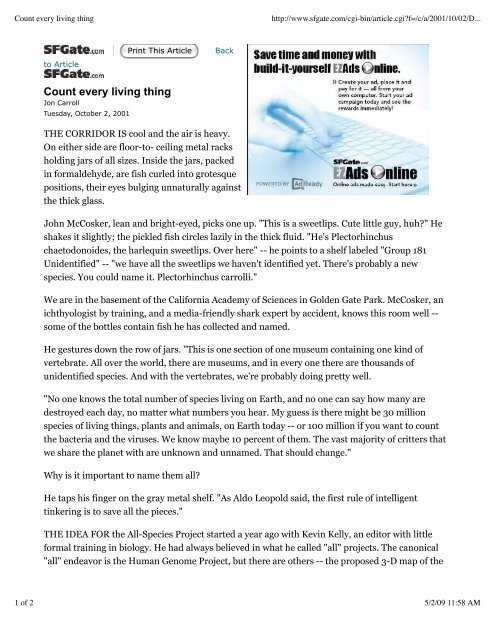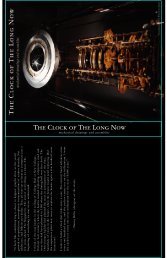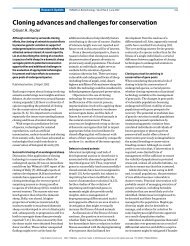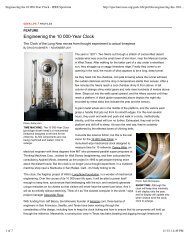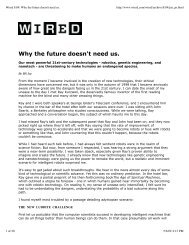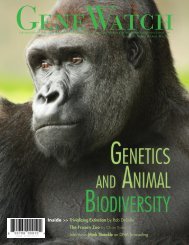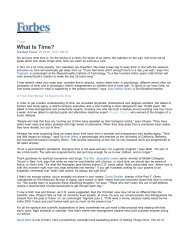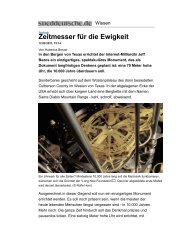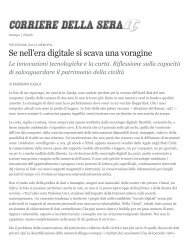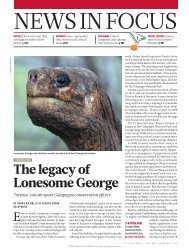Count every living thing - Long Now Foundation
Count every living thing - Long Now Foundation
Count every living thing - Long Now Foundation
Create successful ePaper yourself
Turn your PDF publications into a flip-book with our unique Google optimized e-Paper software.
<strong>Count</strong> <strong>every</strong> <strong>living</strong> <strong>thing</strong> http://www.sfgate.com/cgi-bin/article.cgi?f=/c/a/2001/10/02/D...<br />
to Article<br />
<strong>Count</strong> <strong>every</strong> <strong>living</strong> <strong>thing</strong><br />
Jon Carroll<br />
Tuesday, October 2, 2001<br />
Print This Article Back<br />
THE CORRIDOR IS cool and the air is heavy.<br />
On either side are floor-to- ceiling metal racks<br />
holding jars of all sizes. Inside the jars, packed<br />
in formaldehyde, are fish curled into grotesque<br />
positions, their eyes bulging unnaturally against<br />
the thick glass.<br />
John McCosker, lean and bright-eyed, picks one up. "This is a sweetlips. Cute little guy, huh?" He<br />
shakes it slightly; the pickled fish circles lazily in the thick fluid. "He's Plectorhinchus<br />
chaetodonoides, the harlequin sweetlips. Over here" -- he points to a shelf labeled "Group 181<br />
Unidentified" -- "we have all the sweetlips we haven't identified yet. There's probably a new<br />
species. You could name it. Plectorhinchus carrolli."<br />
We are in the basement of the California Academy of Sciences in Golden Gate Park. McCosker, an<br />
ichthyologist by training, and a media-friendly shark expert by accident, knows this room well -some<br />
of the bottles contain fish he has collected and named.<br />
He gestures down the row of jars. "This is one section of one museum containing one kind of<br />
vertebrate. All over the world, there are museums, and in <strong>every</strong> one there are thousands of<br />
unidentified species. And with the vertebrates, we're probably doing pretty well.<br />
"No one knows the total number of species <strong>living</strong> on Earth, and no one can say how many are<br />
destroyed each day, no matter what numbers you hear. My guess is there might be 30 million<br />
species of <strong>living</strong> <strong>thing</strong>s, plants and animals, on Earth today -- or 100 million if you want to count<br />
the bacteria and the viruses. We know maybe 10 percent of them. The vast majority of critters that<br />
we share the planet with are unknown and unnamed. That should change."<br />
Why is it important to name them all?<br />
He taps his finger on the gray metal shelf. "As Aldo Leopold said, the first rule of intelligent<br />
tinkering is to save all the pieces."<br />
THE IDEA FOR the All-Species Project started a year ago with Kevin Kelly, an editor with little<br />
formal training in biology. He had always believed in what he called "all" projects. The canonical<br />
"all" endeavor is the Human Genome Project, but there are others -- the proposed 3-D map of the<br />
1 of 2 5/2/09 11:58 AM
<strong>Count</strong> <strong>every</strong> <strong>living</strong> <strong>thing</strong> http://www.sfgate.com/cgi-bin/article.cgi?f=/c/a/2001/10/02/D...<br />
universe, for instance. It could be argued that the periodic table of the elements was the first all<br />
project.<br />
Kelly's idea was simple: Why not inventory all life on Earth? "This does several <strong>thing</strong>s," he said<br />
later. "It spreads the money all over the globe into corners where money rarely gets to, it spreads<br />
the good of discovery all over the globe, and it creates the beginnings of a new biology because for<br />
the first time we would know all the parts of the biosphere."<br />
Then as now, Kelly was working with Stewart Brand and others in the Presidio offices of the <strong>Long</strong><br />
<strong>Now</strong> <strong>Foundation</strong>, which is creating a 10,000-year clock in the desert of eastern Nevada. Might this<br />
be a project that <strong>Long</strong> <strong>Now</strong> would be interested in?<br />
KELLY WENT TO work persuading others. A plan began to emerge. Brand and Kelly and Ryan<br />
Phelan, the Internet entrepreneur and medical database specialist who is married to Brand, came<br />
up with some numbers: a 25-year time line; a total endowment of $1 billion.<br />
There was no<strong>thing</strong> exactly like the All-Species Project, but there were many <strong>thing</strong>s sort of like it.<br />
The All-Species Project would offer support and coordination and, using the considerable<br />
engineering brainpower that floats in the <strong>Long</strong> <strong>Now</strong> orbit, new tools for the old task.<br />
Said Kelly: "I emphasized why knowing 'all' is vastly different than just knowing 'most,' and I<br />
suggested how we could really do 'all' by inventing new tools." For his part, Brand realized that<br />
"all" was a useful funding device. "You can't sell 'most,' but you sure can sell 'all.' "<br />
And so it was born, the soon-to-be-nonprofit All Species Inventory or, latterly, just ALL.<br />
Tomorrow: old ways, new tools.<br />
Give me a billion dollars and 25 years, and I can find a lot of beetles.<br />
The headbone's connected to the jcarroll@sfchronicle.com.<br />
http://sfgate.com/cgi-bin/article.cgi?f=/c/a/2001/10/02/DD166108.DTL<br />
This article appeared on page B - 8 of the San Francisco Chronicle<br />
© 2001 Hearst Communications Inc. | Privacy Policy | Feedback | RSS Feeds | FAQ | Site Index | Contact<br />
2 of 2 5/2/09 11:58 AM
<strong>Count</strong> <strong>every</strong> <strong>living</strong> <strong>thing</strong>, II http://www.sfgate.com/cgi-bin/article.cgi?f=/c/a/2001/10/03/D...<br />
to Article<br />
Print This Article Back<br />
<strong>Count</strong> <strong>every</strong> <strong>living</strong> <strong>thing</strong>, II<br />
Jon Carroll<br />
Wednesday, October 3, 2001<br />
The story so far: Earlier this year, a small group<br />
in San Francisco, including author and futurist<br />
Stewart Brand and editor Kevin Kelly,<br />
conceived the idea of ALL, the All Species<br />
<strong>Foundation</strong>, a modest little plan to name and<br />
count <strong>every</strong> <strong>living</strong> species on Earth, a number<br />
that may approach 100 million, in a mere 25 years. The project would, they hoped, promote<br />
biodiversity while quantifying it. But they needed to find out whether their insanely ambitious<br />
dream would meet with any real-world support. .<br />
THE NASCENT GROUP was headed by Ryan Phelan, whose expertise is medical databases and<br />
whose special skill is bottom-line entrepreneurial smarts -- always useful in a group of Big<br />
Dreamers. She took the idea to John McCosker, former director of the Steinhart Aquarium.<br />
He was enthusiastic -- the first real scientist to express an interest -- and so they convened a<br />
meeting of many of the biggest guns in the worlds of biology and taxonomy. The list of attendees is<br />
available at www.all-species. org.<br />
"The amazing <strong>thing</strong> to me," said Brand, "was that a lot of these guys hadn't met each other.<br />
Everybody was impressed to be in the same room with all the other somebodies in the room."<br />
The 35 scientists thrashed out some of the problems that such an inventory might face. There were<br />
bottlenecks <strong>every</strong>where -- in the field, at the museums, in the publication process. The old bag it,<br />
tag it, ship it and forget it methodology was still the norm. Legend has it that at the British<br />
Museum, there are still unidentified species on the shelves that were collected by Charles Darwin.<br />
The pace of identification is glacial, much slower than the rate at which the most biodiverse<br />
habitats are being destroyed.<br />
Plus, a controversy was raging in the hermetic world of taxonomists. The old Linnean system, the<br />
genus-and-species designation (Homo sapiens, Felis catus) that had been invented in the middle of<br />
the 18th century, was thought to be hopelessly outdated by advances in genetics. A new system,<br />
called PhyloCode, was being championed. How are you going to identify all the species on Earth if<br />
there's no general agreement about what to call them?<br />
AND THERE WERE political problems. What is often called "bio-prospecting" --<br />
1 of 2 5/2/09 12:01 PM
<strong>Count</strong> <strong>every</strong> <strong>living</strong> <strong>thing</strong>, II http://www.sfgate.com/cgi-bin/article.cgi?f=/c/a/2001/10/03/D...<br />
searching for cancer cures or high-yield food in Third World countries -- had made some nations<br />
justly suspicious of pale taxonomists with unknown agendas. Plus, some of the richest places on<br />
Earth were also some of the most unstable - - Colombia, for instance, or Congo. Taxonomists have<br />
always been brave people, risking disease and maximal discomfort, but they are not foolish. No<br />
beetle is worth a life.<br />
In the end, though, the verdict was unanimous: Go for it. One of the scientists there, Dr. Evert<br />
Schlinger, an entomologist attached to the California Academy of Sciences, put up $1 million in<br />
seed money to get the project under way. "The enthusiasm was overwhelming," said Phelan, "but<br />
so was the job. We knew we were over our heads. Maybe we could raise a billion and maybe we<br />
couldn't, but we needed a CEO. So we wrote an ad."<br />
BRIAN M. BOOM, the vice president for botanical science and Pfizer Curator of Botany at the New<br />
York Botanical Garden, was lying in bed one night reading a copy of the journal Science. His eye<br />
was caught by a small ad in the back of the magazine:<br />
"All Species CEO Search. The Goal of the All-Species Inventory is to catalog <strong>every</strong> <strong>living</strong> species on<br />
earth within one generation (25 years). . . . Every once in a while there is a chance to do some<strong>thing</strong><br />
grand and good -- send a human to the moon, or sequence a genome. For the right person, making<br />
the first inventory of all <strong>living</strong> species is that chance."<br />
Boom put the magazine down. "That's my job," he said to his wife. "That's what we're doing next."<br />
Tomorrow: Boom time.<br />
The exciting slow-paced world of taxonomy, and how to have fun there.<br />
My house is a very fine house, with two cats in jcarroll@sfchronicle.com.<br />
http://sfgate.com/cgi-bin/article.cgi?f=/c/a/2001/10/03/DD60582.DTL<br />
This article appeared on page B - 8 of the San Francisco Chronicle<br />
© 2001 Hearst Communications Inc. | Privacy Policy | Feedback | RSS Feeds | FAQ | Site Index | Contact<br />
2 of 2 5/2/09 12:01 PM
<strong>Count</strong> <strong>every</strong> <strong>living</strong> <strong>thing</strong>, III http://www.sfgate.com/cgi-bin/article.cgi?f=/c/a/2001/10/04/D...<br />
to Article<br />
Print This Article Back<br />
<strong>Count</strong> <strong>every</strong> <strong>living</strong> <strong>thing</strong>, III<br />
Jon Carroll<br />
Thursday, October 4, 2001<br />
The story so far: Stewart Brand and his plucky<br />
band of adventurers at the <strong>Long</strong> <strong>Now</strong><br />
<strong>Foundation</strong> have gotten seed money to start the<br />
All Species <strong>Foundation</strong>, or ALL, a mildly<br />
ambitious project to count and name <strong>every</strong><br />
species on Earth within 25 years. Since no one<br />
at <strong>Long</strong> <strong>Now</strong> is a trained taxonomist, the group hired Brian M. Boom, former second in command<br />
at the New York Botanical Garden, to be the CEO of the new organization, headquartered at the<br />
Presidio. He started work last month.<br />
IT IS POSSIBLE to see Brian Boom as hopelessly square. He looks like a stereotypical botany<br />
professor -- short, balding, neat -- but he talks with daunting intensity and disarming sincerity. He<br />
spent years doing field work under extremely harsh conditions in Ecuador, Bolivia and Venezuela.<br />
Like Brand, Boom sees ALL as a catalyst, a small, swiftly moving organization putting people in<br />
touch with people, and putting people in touch with ideas. And like writer and editor Kevin Kelly,<br />
he believes that amateurs, what Kelly calls "barefoot taxonomists," have a substantial role to play<br />
in 21st century biology.<br />
"You don't need people with Ph.D.s to collect specimens and tell you what they are," Boom said. "In<br />
<strong>every</strong> place I've worked, there have been indigenous people with a deep understanding of their own<br />
environment -- the names of the plants, where they grow, what they're used for. Our challenge is to<br />
do a country-by-country assessment and find those people."<br />
KELLY, AND other people in the <strong>Long</strong> <strong>Now</strong> orbit, are committed to the notion that new tools will<br />
solve current bottlenecks. "Suppose," said Kelly, "that you could identify a species in the field.<br />
Suppose you had a small device that would process the animal or plant, inventory its<br />
characteristics, check the characteristics against its database and tell you whether you had a new<br />
<strong>thing</strong> or not."<br />
John McCosker, the ichthyologist who's been involved with ALL almost from the beginning, called<br />
that idea "Kevin's Mr. Coffee: You put the bug in the top and, zip, instant taxonomy." But Boom<br />
was intrigued. "New tools can be incredibly important," said Boom. "Already a taxonomist in the<br />
field has a GPS box, and a laptop, maybe even an Internet connection if he can find a satellite<br />
through the rain forest canopy. I don't rule any<strong>thing</strong> out. Clearly, at the pace we are talking about --<br />
1 of 2 5/2/09 12:01 PM
<strong>Count</strong> <strong>every</strong> <strong>living</strong> <strong>thing</strong>, III http://www.sfgate.com/cgi-bin/article.cgi?f=/c/a/2001/10/04/D...<br />
90 percent of the Earth's species in a generation -- we need to do <strong>thing</strong>s a different way."<br />
This sense of urgency drives a lot of biologists. The rain forest is being destroyed; the coral reefs<br />
are dying from pollution and predators of opportunity; the northern forests are being logged. The<br />
events of Sept. 11 do not change this; the planet is under attack even as humans attack each other.<br />
ONE OF THE most daunting challenges to ALL is based in human psychology: Most unidentified<br />
species are not big-eyed furry creatures or majestic birds; they are tiny brown beetles and fungi<br />
that look like ant vomit. And yet they are as important a part of the ecosystem as spotted owls or<br />
gray whales or pandas. As Richard Pyle, a member of the ALL advisory board and a deep-sea<br />
explorer and ichthyologist attached to the Bishop Museum in Hawaii, said:<br />
"The life forms we hope to document are disappearing faster than we can document them. Unlike<br />
many other of humanity's great endeavors, the documentation of all species is a race against time.<br />
Human impacts to the environment are driving legions of species to extinction. We can't know that<br />
a species has gone extinct until we know it exists. How can we estimate the cost of this global<br />
extinction when we are only aware of a small fraction of what we've lost? We owe it to future<br />
generations to document these species before they are gone."<br />
What we're talking about here is saving the planet. Let's keep it our secret.<br />
And I think to myself, what a wonderful jcarroll@sfchronicle.com.<br />
http://sfgate.com/cgi-bin/article.cgi?f=/c/a/2001/10/04/DD20366.DTL<br />
This article appeared on page B - 12 of the San Francisco Chronicle<br />
© 2001 Hearst Communications Inc. | Privacy Policy | Feedback | RSS Feeds | FAQ | Site Index | Contact<br />
2 of 2 5/2/09 12:01 PM


